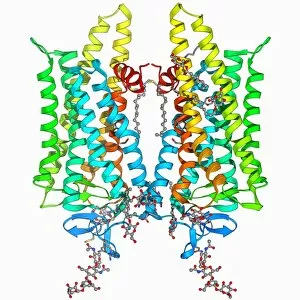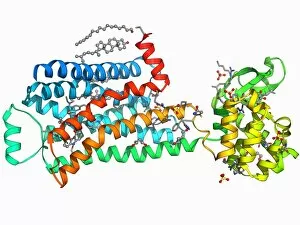G Protein Coupled Receptor Collection
G protein-coupled receptors (GPCRs) play a crucial role in various biological processes, including the binding of cannabinoids to cannabinoid receptors
All Professionally Made to Order for Quick Shipping
G protein-coupled receptors (GPCRs) play a crucial role in various biological processes, including the binding of cannabinoids to cannabinoid receptors. These receptors are depicted in stunning artwork that showcases their intricate structures and functions. One such artwork features the Metarhodopsin molecule F006/9709, which is involved in visual perception. Its counterpart, the Opsin molecule F006/9665, also contributes to vision by absorbing light and initiating signal transduction. Another captivating piece portrays the Beta-2 adrenergic receptor molecule F006/9643, known for its involvement in regulating heart rate and bronchial smooth muscle relaxation. Similarly, its close relative Beta-2 adrenergic receptor molecule F006/9640 plays a critical role in mediating responses to adrenaline. The Rhodopsin molecule F006/9325 takes center stage as it serves as a photosensitive pigment found in rod cells of our eyes. This essential GPCR enables us to perceive light and shapes our visual experiences. Additionally, we have the Beta-2 adrenergic receptor molecules C015/8456 and C015/8455 featured alongside another representation of Rhodopsin. These GPCRs contribute to various physiological responses like vasodilation and bronchial smooth muscle relaxation. Lastly, we encounter two more depictions of Rhodopsin along with Opsin molecules C016/0723 and C016/0635. These GPCRs participate in phototransduction pathways responsible for converting light into electrical signals that enable us to see colors vividly. Through these mesmerizing artworks showcasing diverse GPCRs like cannabinoid receptors or those involved in vision or physiological responses like heart rate regulation or bronchial relaxation, we gain insight into the fascinating world of G protein-coupled receptors – vital molecular players shaping our sensory experiences and bodily functions.









